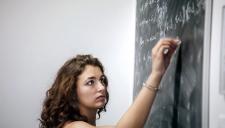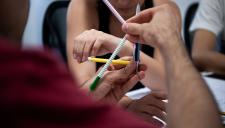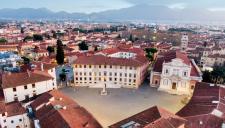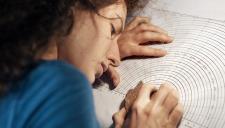illustrazioni per The Last Resort, testo di J. Patrick Lewis, Mankato, Minnesota, Creative Editions, 2002. Acquerelli e chine colorate su carta Fabriano.
The exhibition, curated by Giorgio Bacci, hosted by Fondazione Palazzo Blu and sponsored by Scuola Normale Superiore, is one of the biggest dedicated to Roberto Innocenti, presenting 100 original plates of one of the world’s most famous illustrators: his books have been translated into many languages (English, German, French, Japanese, etc.), reaching a wide and varied audience. Award-winning, Innocenti is the only Italian artist to have received the so-called ‘Nobel of illustration’: the Hans Christian Andersen Award, in 2008.
Innocenti’s relationship with contemporary society is expressed in his pledge for constant social commitment. It is no coincidence that he obtained international success with a book like Rose Blanche – where the tragedy of deportation and war is relived through the eyes of a child; this work was first published in Switzerland in 1985 and was immediately awarded the Prize for Peace Gustav Heinemann and the Das Rote Tuch. It is, however, not the only circumstance in which Innocenti deals with the Shoah; he also addresses the theme in the dense and sadly spectacular Erika’s story.
The original drawings of these two volumes open the exhibition together with the plates taken from The House, which combines the theme of historical memory with that of the contemporary ‘non-place’. The book tells indeed the story of a farmhouse in the Tuscan countryside through the twentieth century.
The common thread of the non-place accompanies the visitor in the second room, where The Girl in Red, The Last Resort and Cinderella are presented. In the first book Innocenti recounts the adventures of a modern Little Red Riding Hood struggling with the pitfalls of contemporary society, including blinding advertising and flashing signs, reminiscent in some ways of American Pop Art. In the latter, the visitor shares a particular space, the artist’s inventive memory itself, meeting some of the most famous authors and literary characters in a mysterious inn by the sea. Finally, Cinderella offers another retelling of the classic fairy tale: Innocenti sets the story in England during the Twenties and Thirties, in an Art Deco style.
Pinocchio and A Christmas Carol close the exhibition in the third room. In the second book, Innocenti essentially re-reads Dickens through paintings that evoke the lesson of a great painter like Hogarth, while in the first text, the illustrator, in keeping with the spirit of Collodi’s masterpiece, places the adventures of the famous puppet in a wonderful nineteenth-century Tuscan countryside.
Text accompanying the exhibition: G. Bacci, Roberto Innocenti. The art of inventing books, Pisa, Istos Edizioni, 2016.
INFO
ROBERTO INNOCENTI
L’arte di inventare i libri
Palazzo Blu, 9 luglio – 16 ottobre 2016
Ingresso gratuito
dal martedì al venredì dalle 10.00 alle 19.00
sabato e domenica dalle 10.00 alle 20.00
(ultimo ingresso un’ora prima della chiusura)
illustrazioni per The Girl in Red, testo di Aaron Frisch, Mankato, Minnesota, Creative Editions, 2012. Tempera verniciata su carta.
Illustrazioni per The Last Resort, testo di J. Patrick Lewis, Mankato, Minnesota, Creative Editions, 2002. Acquerelli e chine colorate su carta Fabriano.
illustrazioni per Cinderella, testo di Charles Perrault, Mankato, Minnesota, Creative Education, 1983. Acquerello su carta Fabriano.











